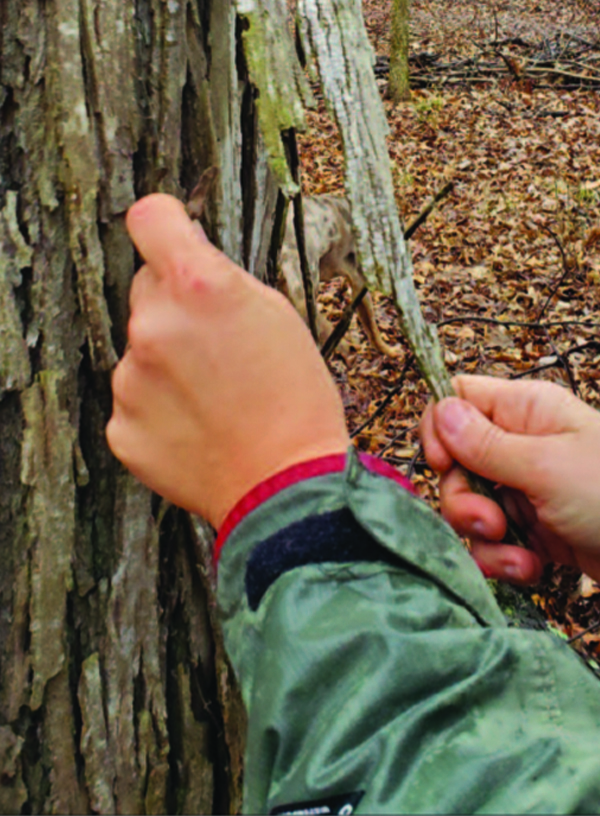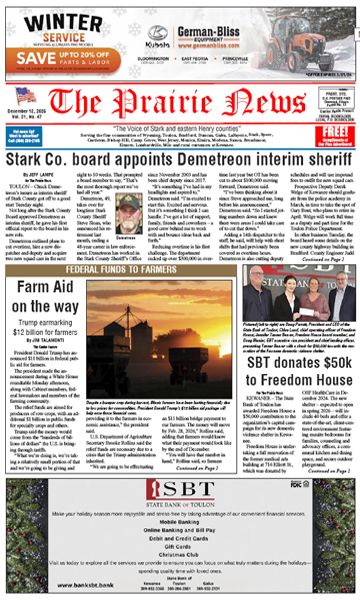Bark of hickory trees can be used in tasty syrup

By GRETCHEN STEELE
For The Weekly Post
When you think about using hickory in the kitchen most folks will think of hickory smoked something – a few will think of using the sweet little nut meats, but it’s unlikely that many will think of syrup. Yes, shagbark hickory bark syrup – an easy-to-make syrup that for many is preferred over maple syrup, and is certainly far easier to make.
Made from the bark of the decidedly shaggy and messy shagbark hickory (Carya ovata), hickory syrup is so much simpler and less time consuming to make than the traditional tapping and cooking down of maple syrup. It’s literally a oneday project.
Depending on how readily available shagbark hickory trees are, making syrup can be a morning activity. And while maple tapping season is short, hickory bark syrup can really be made any time of the year you are out in the forest among shagbark hickories.
The history of hickory syrup is a little sketchy. Some recipes have been handed down through the generations, especially in Appalachian areas. My own recipe is one of those that’s been handed down through the years through generations of a family of foragers and woodsmen.
Some surmise that early settlers learned the method from Native Americans they encountered. Regardless of how it came to be, hickory syrup is a great project for a forager.
How to describe hickory syrup to a generation that has grown up on that cheap, imitation maple syrup stuff? The hickory version is certainly sweet and syrupy, but it has a nutty, slightly spicy smokiness to the flavor as well. I use it just as I would use maple syrup – on pancakes and toast, in glazes, sauces and stirred into cocktails.
Hickory syrup is really simple – yes, I’m saying that again, and loudly. It’s simple to collect the ingredients (bark, cane sugar and water) and simple to make. It’s hard to misidentify a shagbark hickory – the bark is very distinctive in its shaggy, peeling nature.
It’s important to note that harvesting the bark doesn’t hurt the tree, as long as you only break off loose, peeling, pieces of bark that aren’t fully attached to the trunk. The danger of over harvest is small as well. Most recipes only call for a pound of bark. When gathering, look for clean bark that doesn’t have either the greenishwhite lichens or the whitish, web like fungus that can sometimes inhabit loose pieces of hickory bark. Bark with these elements will most certainly give your syrup an off or bitter taste and might cause gastric upset.
Now that you know what kind of bark to collect, it’s time to get busy making some syrup!
To make syrup, you’ll need 1 pound of shagbark hickory broken into 4- to 6-inch long pieces, cane sugar and water.
When collecting the bark, break off sections that are loose to avoid damaging to the tree. Once home, use a stiff brush and scrub the bark well under running water. This helps to ensure that you have thoroughly removed any dirt, lichens, or tiny insects that might be hiding in the bark. It’s important to make sure the bark is clean, then pat it dry with a clean dish towel.
Preheat your oven to 325 degrees and spread the clean bark onto a baking sheet. Roast the bark for 25-30 minutes until it becomes a nice, toasty brownish color and you can smell the hickory scent. Remove bark from the oven and allow to cool.
Place roasted bark in a large pot. Cover with cold water and place on medium high heat. Bring water to a boil and then reduce heat to simmer for 30 minutes. Remove the pot from the heat and allow the “bark tea” to cool.
Once cool, remove the bark and filter the hickory tea through cheesecloth or a coffee filter to remove any bits of bark that might be leftover.
Measure the amount of hickory tea left from the process. Measure an equal amount of cane sugar. For example, 7 cups of hickory tea would require 7 cups of cane sugar.
Bring the filtered hickory tea to a boil, then add the sugar. Stir, stir, and stir some more to insure that the sugar has dissolved completely. (Any undissolved sugar crystals can result in the syrup crystalizing over time). Continue boiling the mixture until the syrup thickens, about 225 degrees Fahrenheit on a candy thermometer, and the total amount of liquid has reduced by 25-30 percent.
Sterilize canning jars (half-pint or pint), lids and rings in a boiling water bath. Using a large pot with a wire rack in the bottom place the jars upright on the wire rack and fill with hot water to an inch above the jar level. Bring to a boil and continue boiling for 10 minutes, then remove from heat. Boil the lids and rings in separate smaller saucepan also for 10 minutes. Transfer the sterilized jars, turned upside down, along with the lids and rings to a clean wire rack to dry.
Pour the hot syrup into the sterilized jars to onehalf inch of the top. Place a jar lid on top and secure with a ring. As the syrup cools, the lid should seal to the jar with an clearly audible pop. After the syrup has cooled completely, remove the rings and check for a tight seal. The unopened syrup will stay good for roughly a year, however once it is opened it must be refrigerated.
That’s all there is to it – and the syrup can be used any place you would normally enjoy maple syrup. Drizzle over ice cream, use to make a glaze or sauce for hickory smoked meats, slap on your pancakes – any way you use it, you’ll be glad you made some shagbark hickory syrup!







